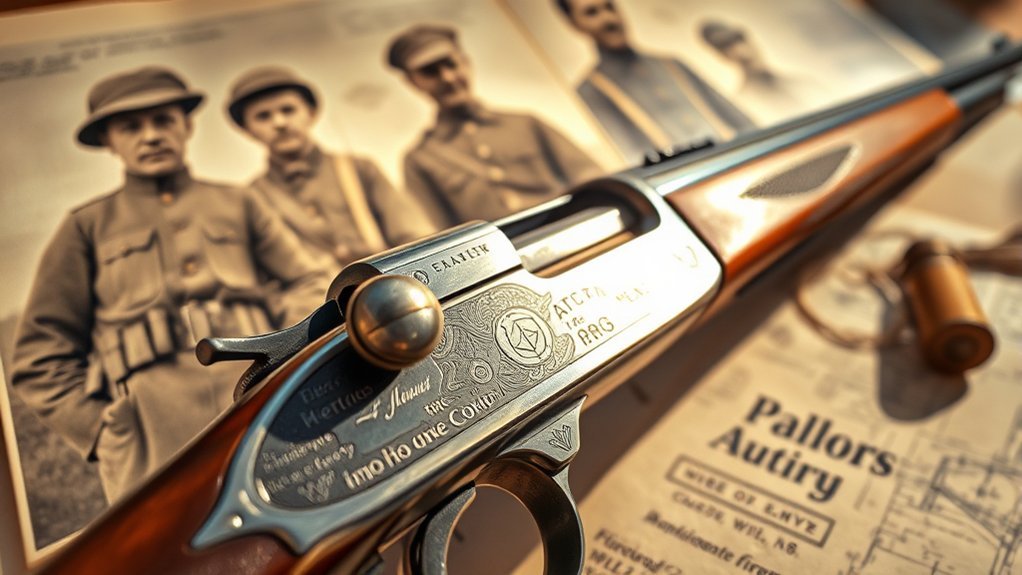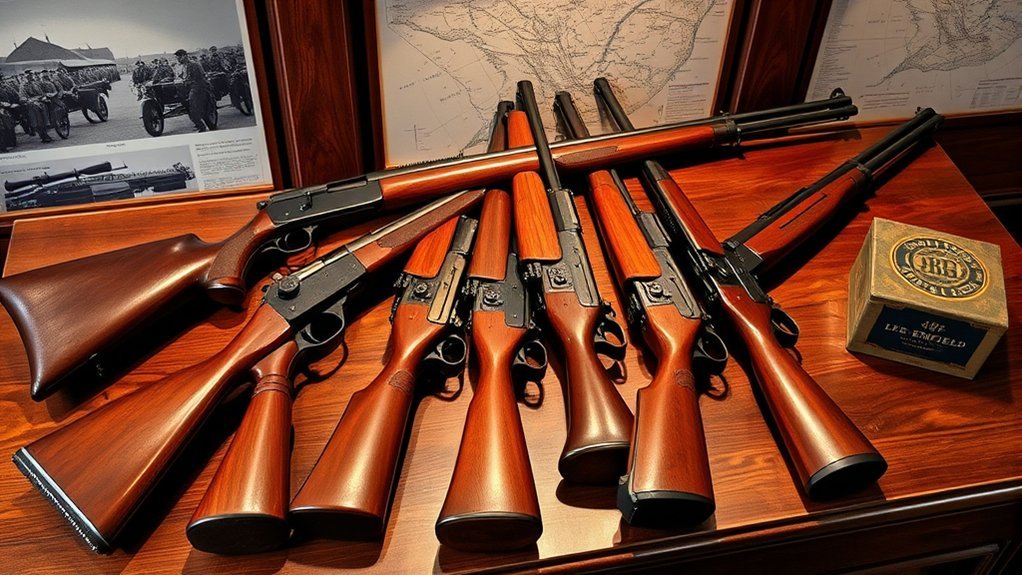Over 80% of military rifles used in the 20th century were bolt-action designs. This statistic underscores the profound impact these rifles had on warfare and military strategy. Their ability to combine precision with rapid reloading changed the dynamics of battle. Yet, the evolution of the bolt-action rifle is a complex story filled with innovation and adaptation. What factors contributed to its enduring legacy in both military and civilian arenas?
The Birth of Bolt-Action Rifles

Although the origins of bolt-action rifles can be traced back to the early 19th century, their development marked a significant evolution in firearm technology. You’ll notice that the design allowed for a more efficient reloading process compared to previous mechanisms. By employing a rotating bolt that could securely lock into the chamber, these rifles increased accuracy and reliability. The introduction of metallic cartridges further enhanced their functionality, enabling faster follow-up shots. As you explore the mechanics, consider how the bolt-action system simplified operation while maintaining robustness. This innovation not only appealed to civilian hunters but also set the stage for military applications, ultimately influencing the design of future firearms. Recognizing these advancements highlights the importance of bolt-action rifles in historical context.
Early Innovations and Military Adoption

As you explore the early innovations in bolt-action rifle designs, you’ll notice how these advancements revolutionized military firearms. The integration of these rifles into armed forces not only enhanced firing rates but also improved accuracy, fundamentally altering combat strategies. Understanding their impact helps you appreciate the pivotal role they played in shaping modern warfare.
First Bolt-Action Designs
The evolution of the bolt-action rifle began in the mid-19th century, marking a significant change in firearm technology and military strategy. Early designs, such as the Dreyse needle gun and the Peabody rifle, introduced the concept of a manually operated bolt mechanism. These innovations allowed for faster reloading and increased accuracy, addressing the limitations of earlier muzzle-loading firearms. The incorporation of metallic cartridges also played a vital role in these designs, enhancing reliability and efficiency. As military forces recognized the advantages of bolt-action rifles in combat, they began adopting these systems. This shift laid the groundwork for future developments, ultimately influencing the design and functionality of rifles used in subsequent conflicts.
Military Integration and Impact
When military leaders recognized the strategic advantages of bolt-action rifles, they swiftly integrated these innovative firearms into their arsenals, transforming warfare in the late 19th and early 20th centuries. The precision and rapid-fire capability of these rifles allowed soldiers to engage effectively from greater distances. This shift not only enhanced battlefield tactics but also influenced training and logistics.
| Year | Model | Country |
|---|---|---|
| 1895 | M1895 Mauser | Germany |
| 1903 | Springfield M1903 | United States |
| 1907 | Lee-Enfield Mk III | United Kingdom |
| 1917 | P14 Enfield | United Kingdom |
As a result, bolt-action rifles became the standard for infantry units, setting the stage for modern military engagements.
Key Models That Shaped History

Throughout the evolution of warfare, several bolt-action rifles have emerged as pivotal instruments that not only shaped military strategy but also influenced the design of firearms. You’ll find that models like the Mauser 98 revolutionized bolt-action design with its controlled feed, enhancing reliability under combat conditions. The Lee-Enfield, known for its rapid cycling and 10-round magazine, transformed infantry tactics, allowing soldiers to deliver sustained fire. Meanwhile, the American Springfield 1903 combined precision with adaptability, becoming a favorite among marksmen. Each of these models introduced innovations that addressed specific battlefield needs, setting standards for future designs. Understanding these key models helps you appreciate the profound impact they had on both military operations and the evolution of firearm technology.
The Role of Bolt-Action Rifles in World Wars
In both World Wars, bolt-action rifles became essential tools for achieving battlefield accuracy and extended range, fundamentally shaping military engagements. As tactics evolved to incorporate more strategic positioning and precision, these rifles demonstrated their effectiveness in various combat scenarios. You’ll also encounter several iconic models that not only influenced the design of future firearms but also left a lasting mark on military history.
Battlefield Accuracy and Range
Although bolt-action rifles were often overshadowed by automatic weapons in the chaos of World War battles, their battlefield accuracy and range made them indispensable for marksmen and snipers. You’ll notice that these rifles excelled in precision shooting at long distances, allowing skilled operators to engage targets effectively beyond the reach of semi-automatic counterparts. The inherent design of the bolt-action mechanism provided a stable platform for accuracy, minimizing recoil and enhancing shooter control. Additionally, the use of high-velocity cartridges further increased effective range, enabling snipers to disrupt enemy operations from afar. During essential engagements, the combination of these factors led to significant tactical advantages, proving that despite rapid technological advancements, the bolt-action rifle remained an important tool in the arsenal of military forces.
Evolution of Military Tactics
The effectiveness of bolt-action rifles greatly influenced the evolution of military tactics during the World Wars. These rifles provided soldiers with unmatched accuracy and range, which shifted the focus from massed infantry assaults to more strategic approaches. You’d notice that commanders began to emphasize cover, concealment, and coordinated fire support, recognizing the lethal potential of a single, well-placed shot. This led to the development of sniper units, transforming the battlefield into a space where individual skill became paramount. As you observe the tactics employed, it becomes clear that the presence of bolt-action rifles necessitated a more dispersed formation, allowing troops to leverage their firepower effectively while minimizing vulnerability. Ultimately, these changes laid the groundwork for modern infantry tactics.
Iconic Bolt-Action Models
Bolt-action rifles stand as iconic symbols of military innovation during the World Wars, profoundly shaping battlefield dynamics. You’ll find models like the British Lee-Enfield, renowned for its rapid-fire capability, which gave soldiers a tactical edge in trench warfare. Similarly, the German Mauser 98, with its robust design and accuracy, became a standard against which other rifles were measured. These rifles not only enhanced individual marksmanship but also influenced infantry tactics, promoting the use of cover and precision shooting. The American Springfield 1903 showcased advancements in rifling and sights, essential for long-range engagements. Collectively, these models epitomized reliability and performance, fundamentally altering the nature of combat and establishing a legacy that continues to inform modern firearms design.
Advancements in Design and Technology
As advancements in design and technology emerged throughout the late 19th and early 20th centuries, the bolt-action rifle underwent significant transformations that enhanced its efficiency and effectiveness on the battlefield. Innovations like the introduction of the Mauser system improved feed reliability and reduced jamming, while advancements in metallurgy allowed for lighter, stronger components. You’d notice the shift towards more ergonomic designs, making these rifles easier to handle and aim, especially in rapid-fire situations. The integration of internal magazine systems allowed for quicker reloading, streamlining the user experience. Furthermore, the advent of smokeless powder drastically increased muzzle velocity and range, further solidifying the bolt-action rifle’s reputation as a formidable weapon in military engagements. These enhancements collectively transformed the bolt-action into an indispensable tool for soldiers.
The Bolt-Action Rifle in Modern Context
While many modern firearms have evolved to prioritize rapid-fire capabilities and automation, the bolt-action rifle continues to hold a significant place in both military and civilian contexts. Its enduring popularity stems from several key factors:
- Accuracy: The bolt-action design inherently provides superior precision, making it a favorite among marksmen and hunters.
- Reliability: With fewer moving parts compared to semi-automatics, bolt-action rifles are less prone to malfunctions, particularly in adverse conditions.
- Versatility: Available in various calibers and configurations, these rifles cater to a wide range of shooting disciplines, from long-range target shooting to big game hunting.
Conclusion
In conclusion, the evolution of the bolt-action rifle illustrates how innovation can change the course of history. From its inception to its widespread military and civilian use, this firearm has proven its worth time and again. As you explore its legacy, remember that these rifles not only represent technological advancements but also embody the spirit of their times. The bolt-action rifle remains a tribute to the adage that necessity is the mother of invention, shaping the future of firearm design.

